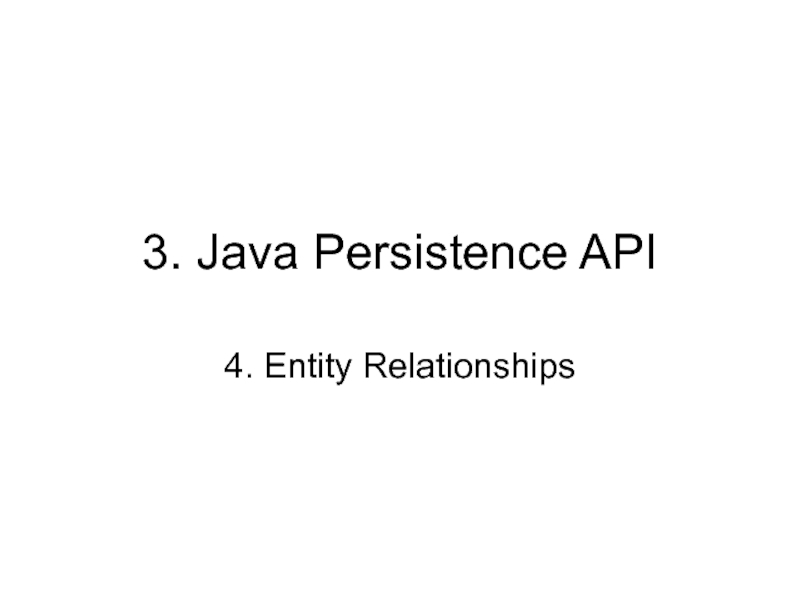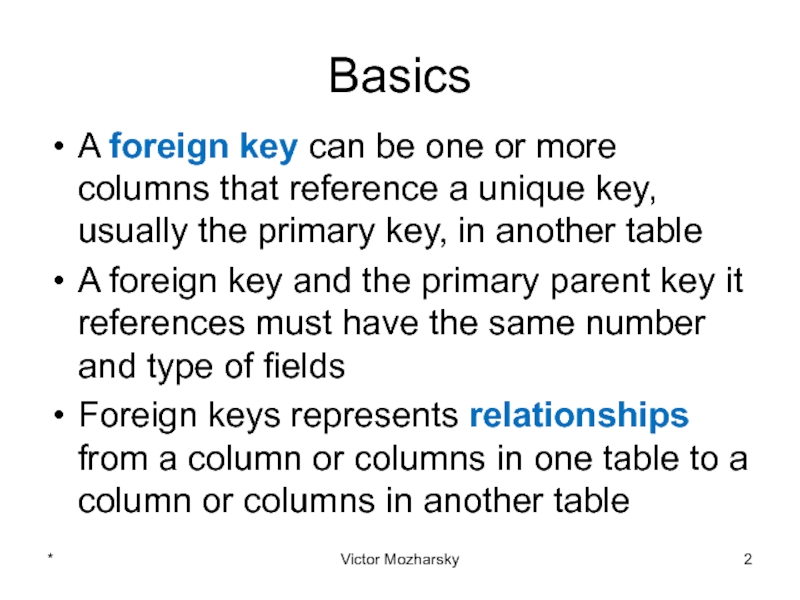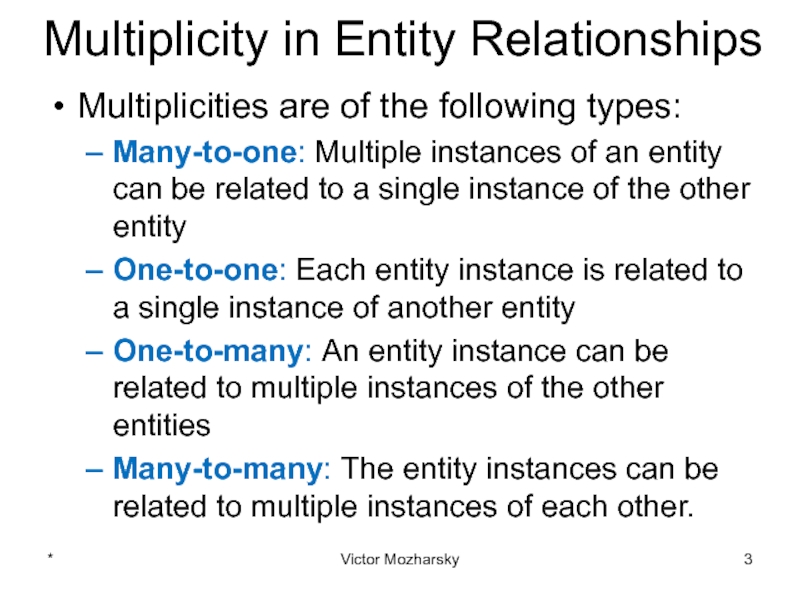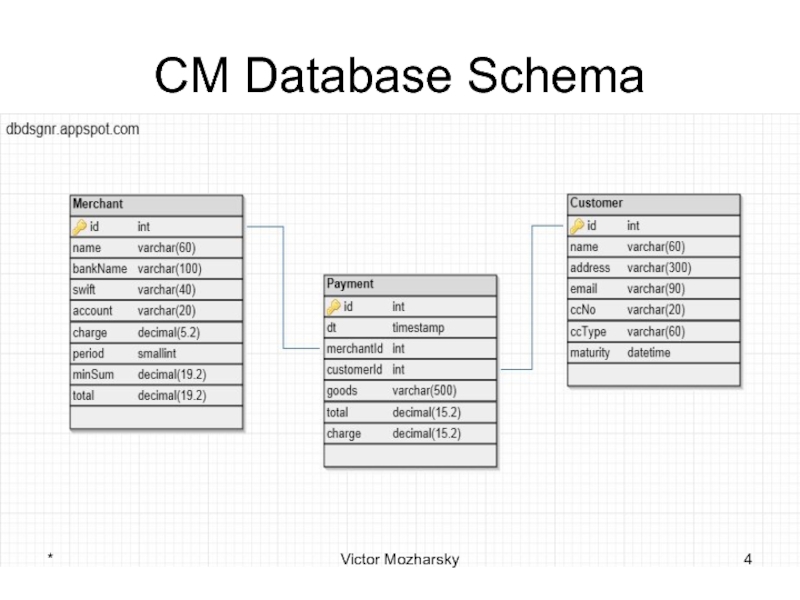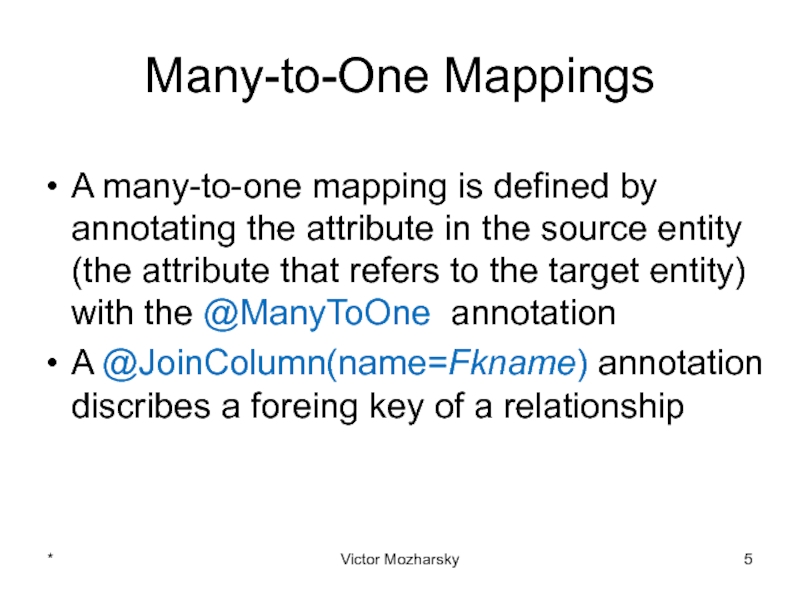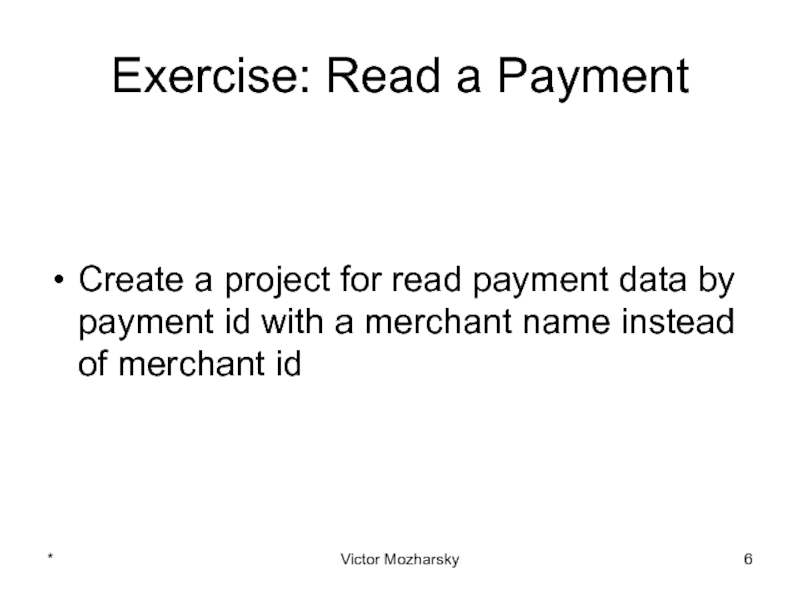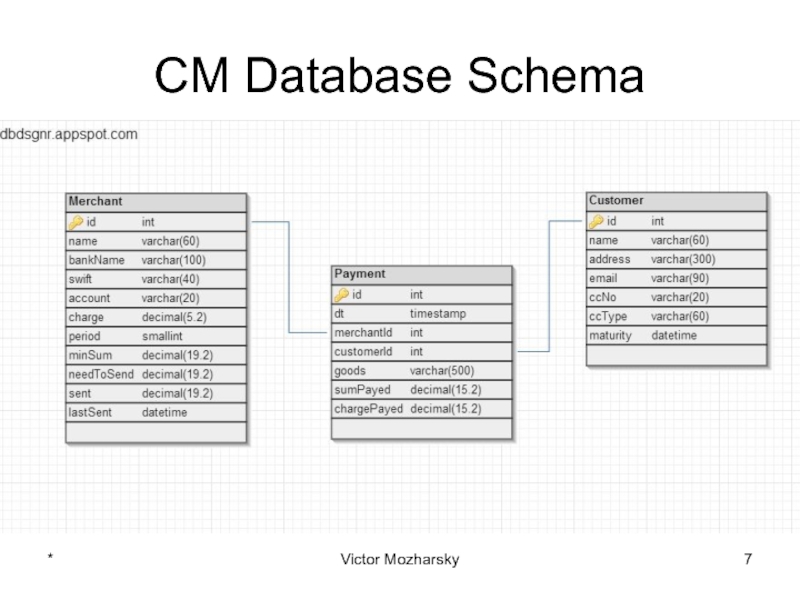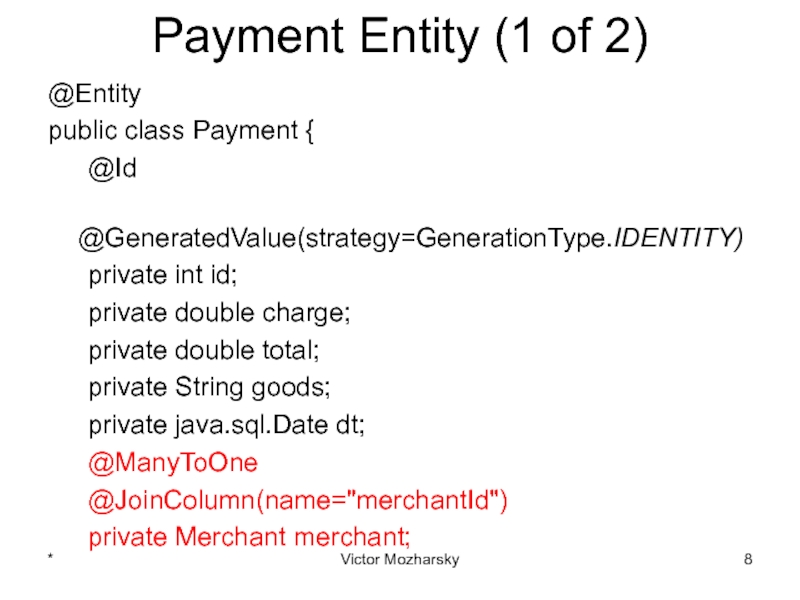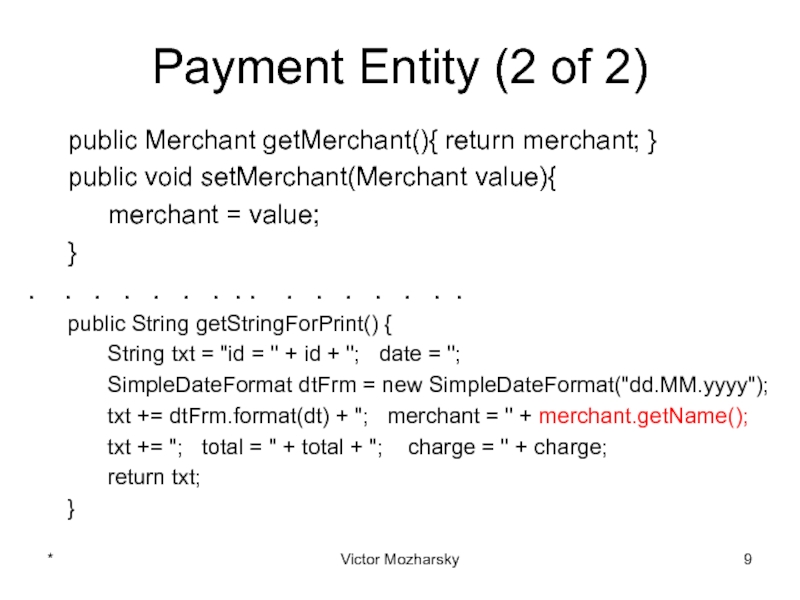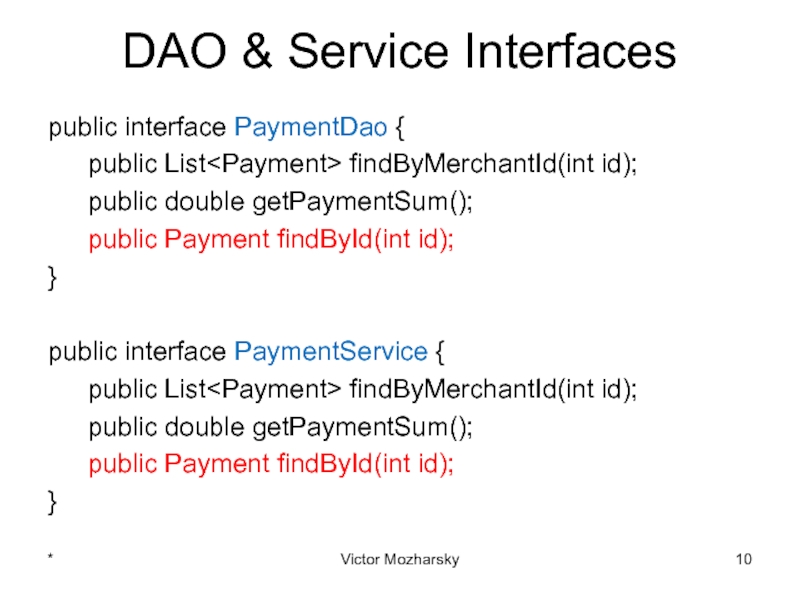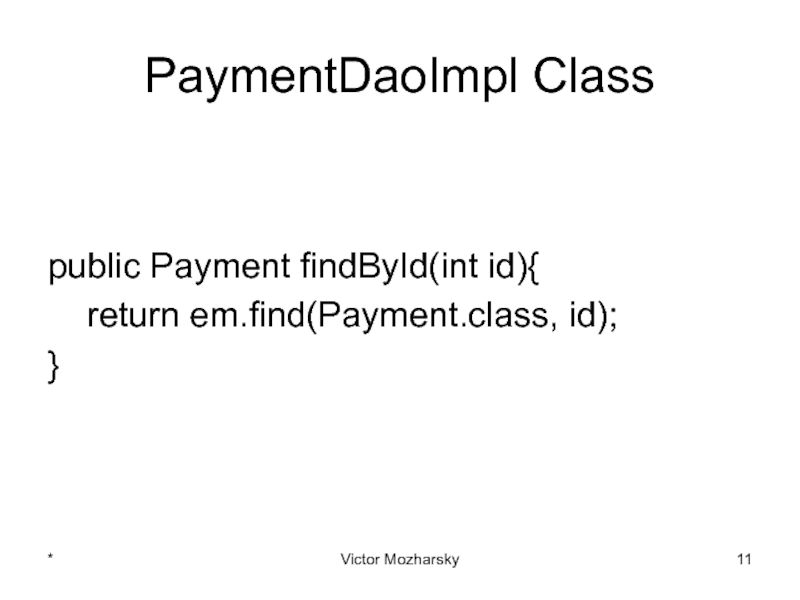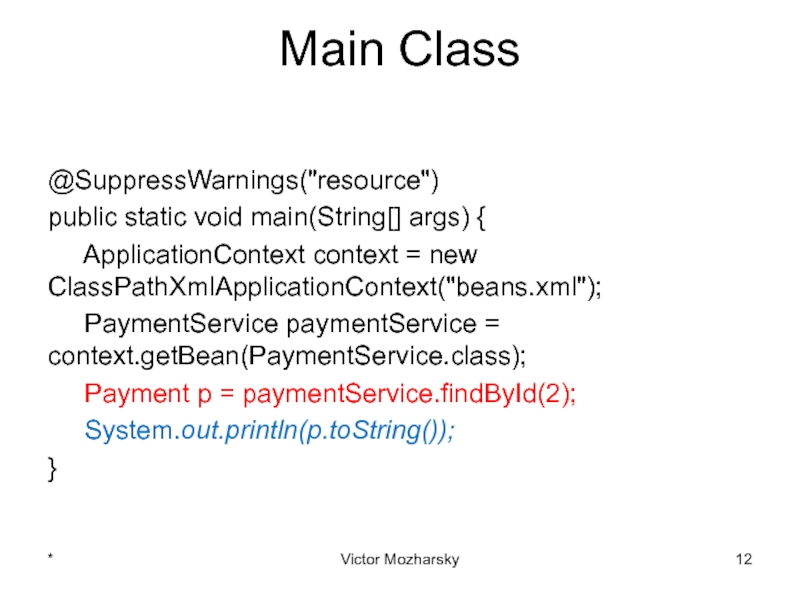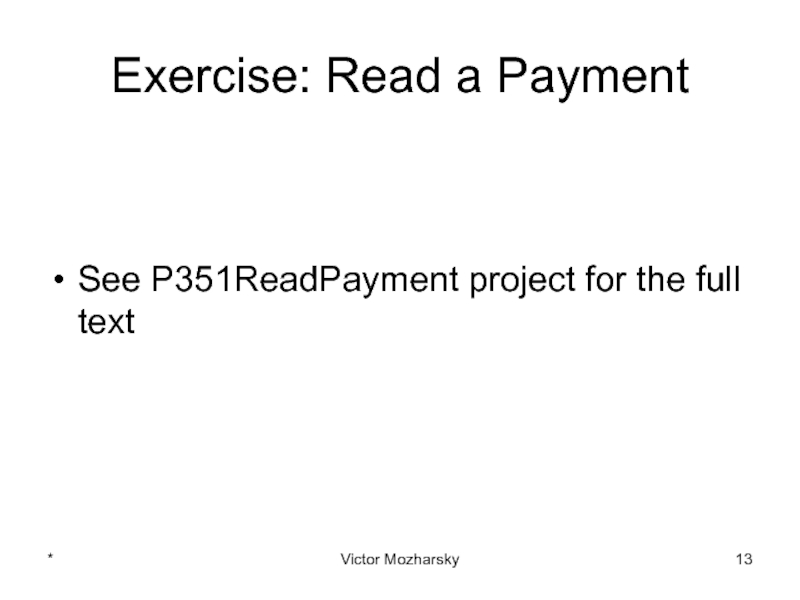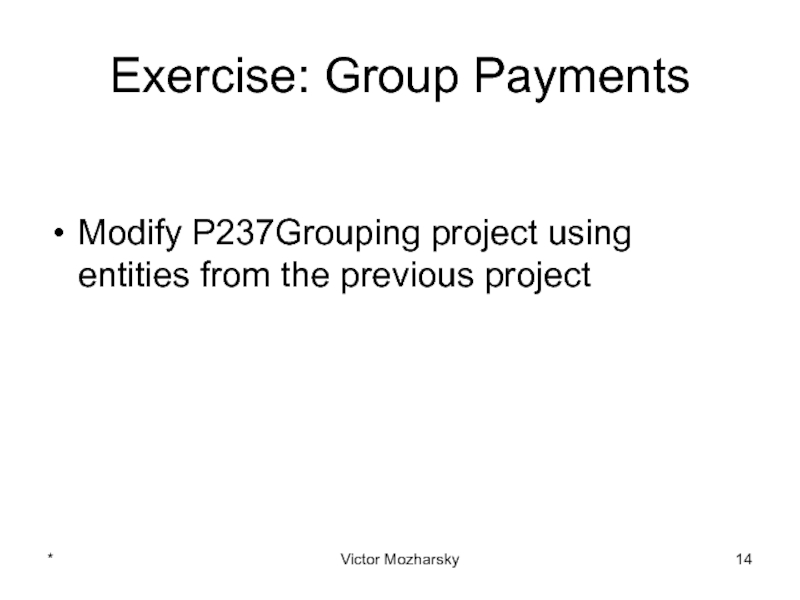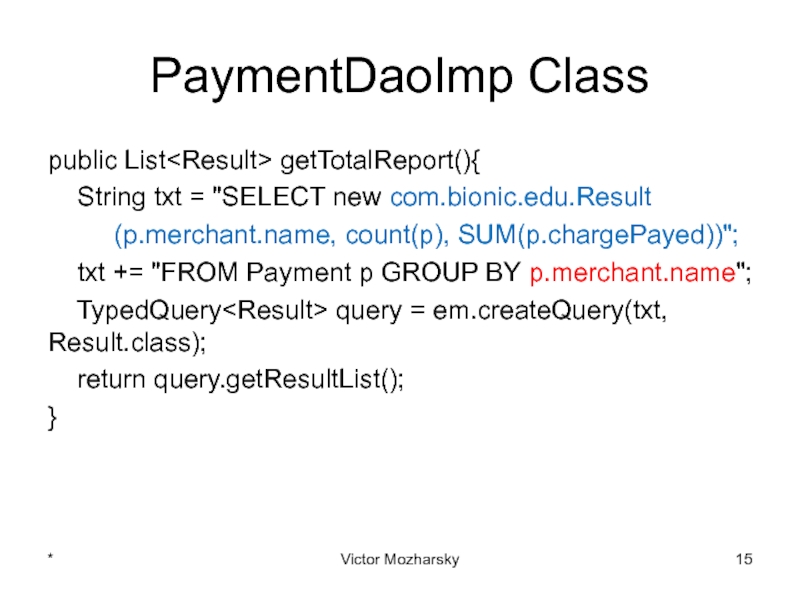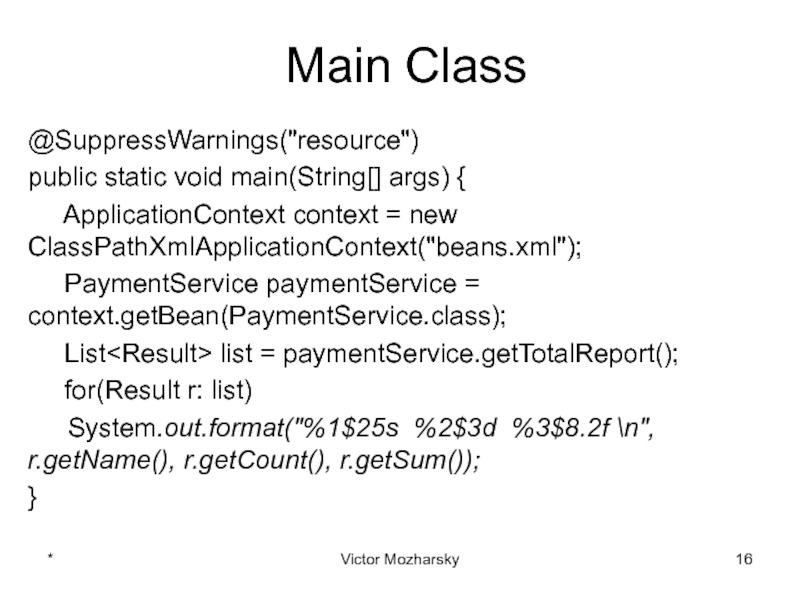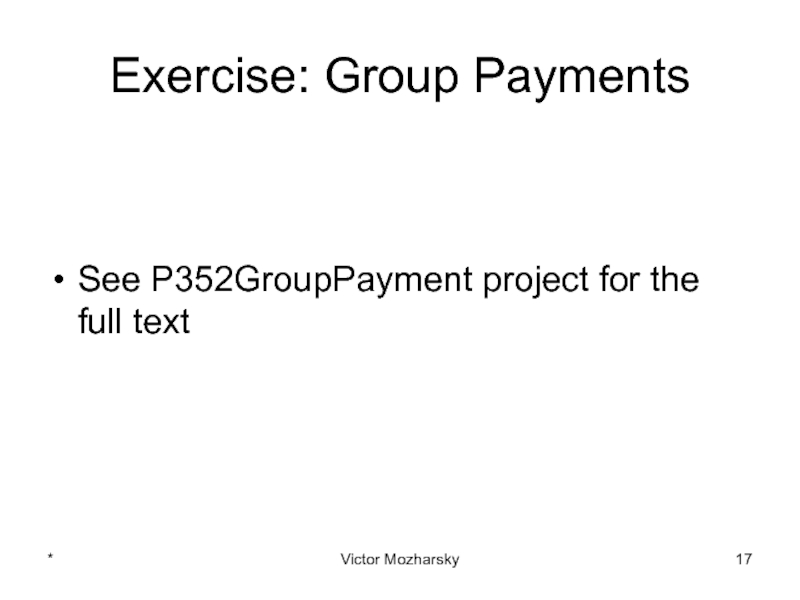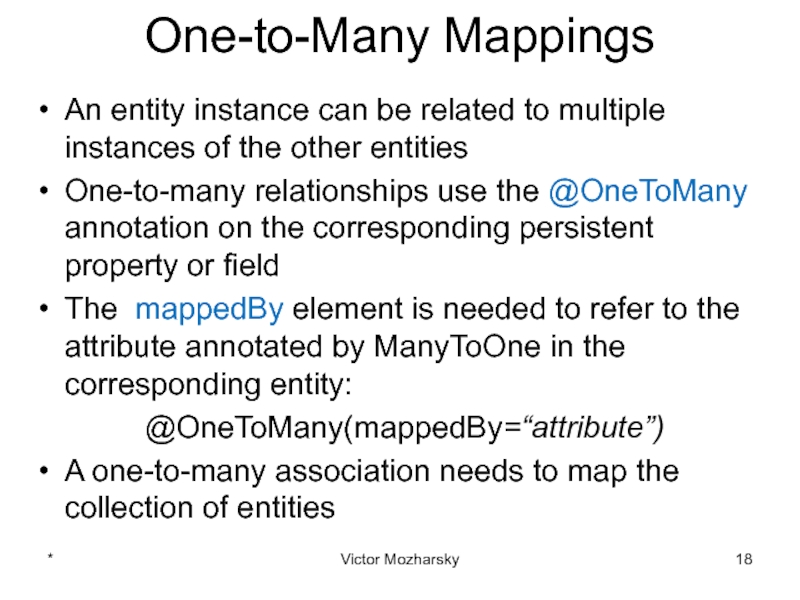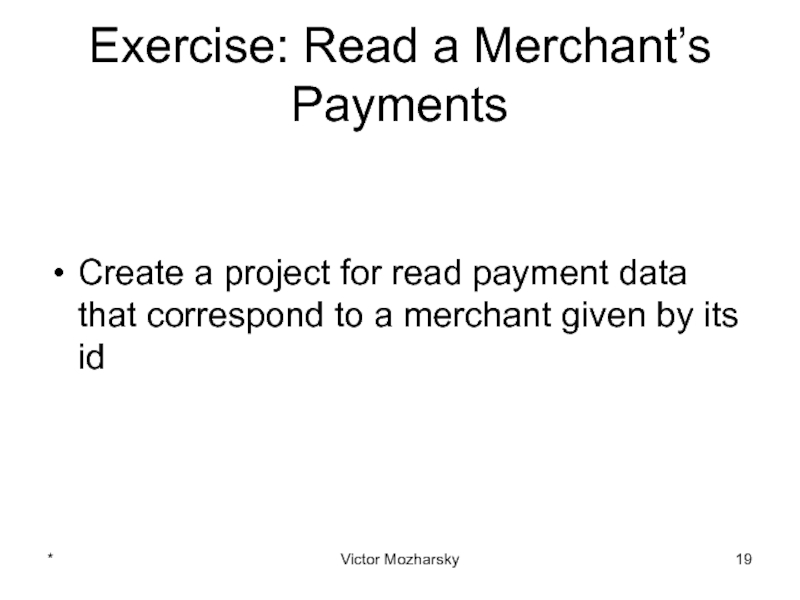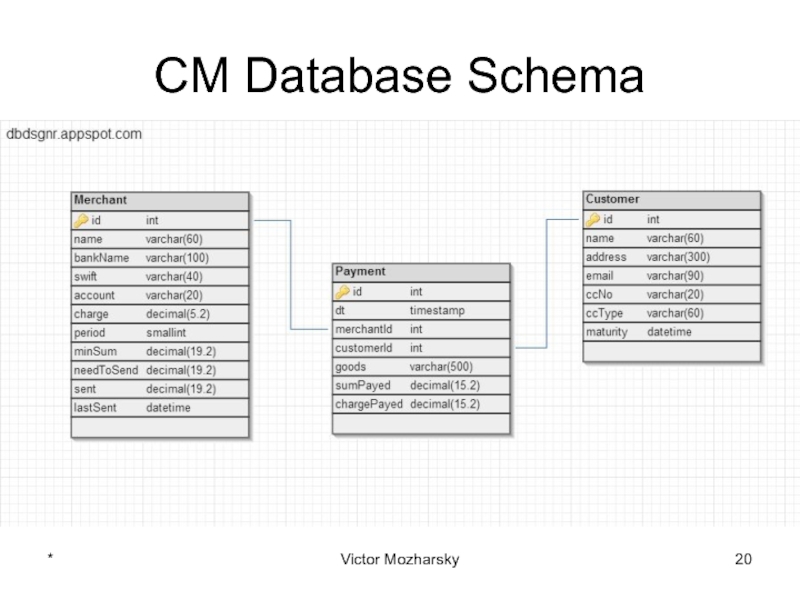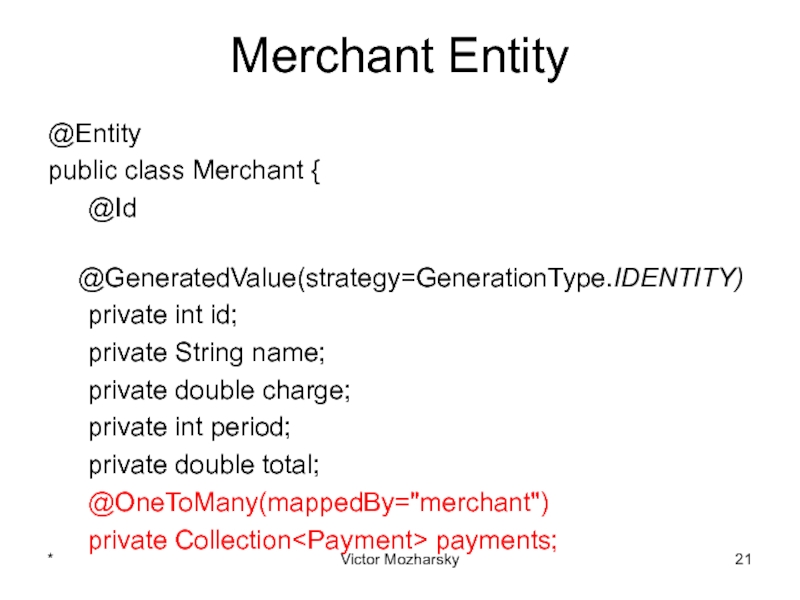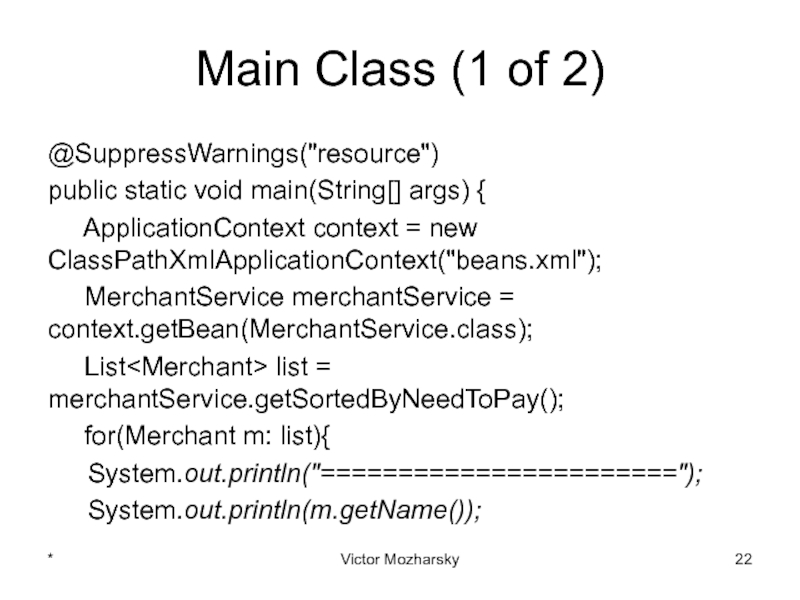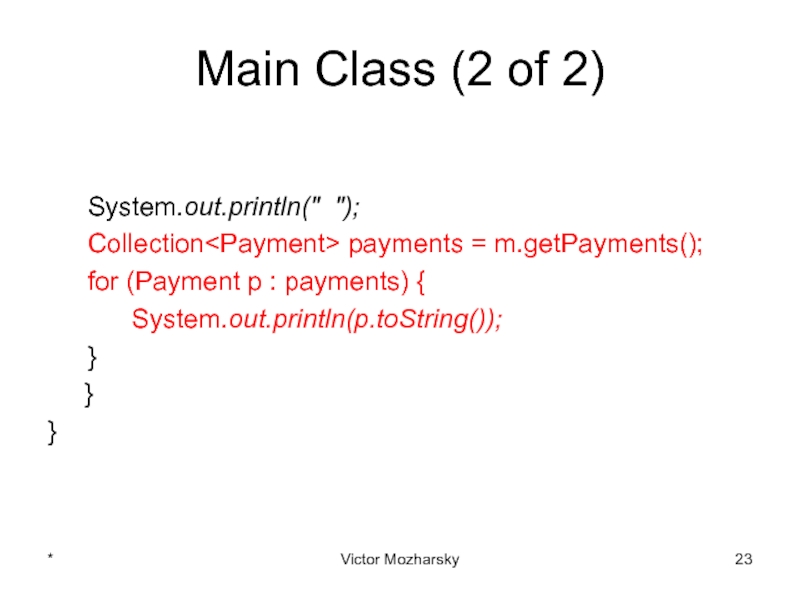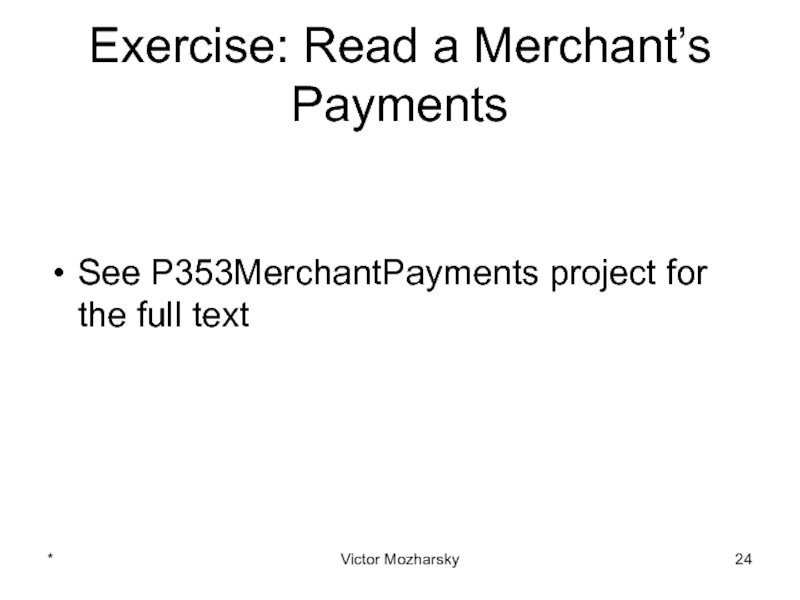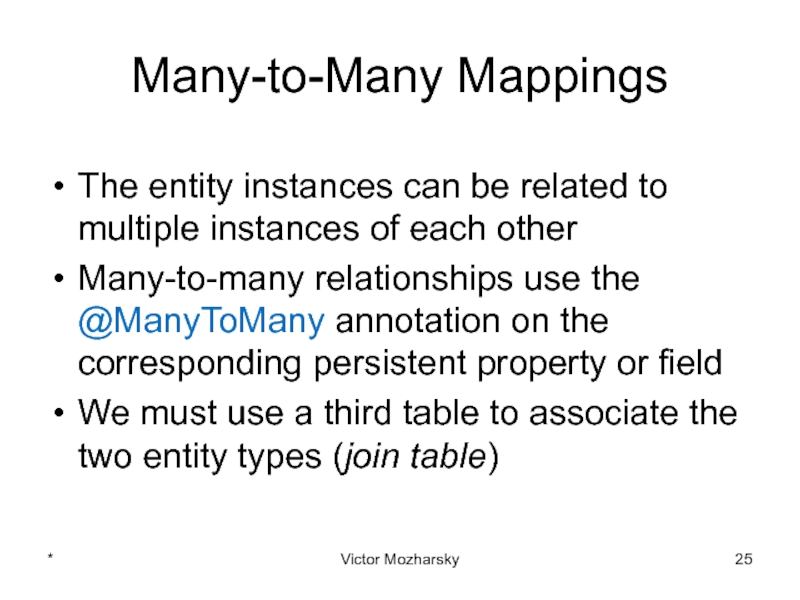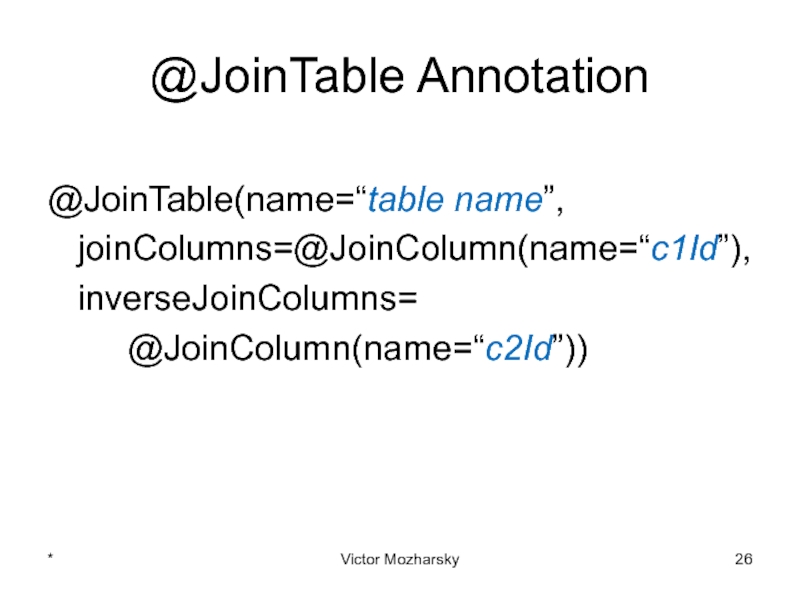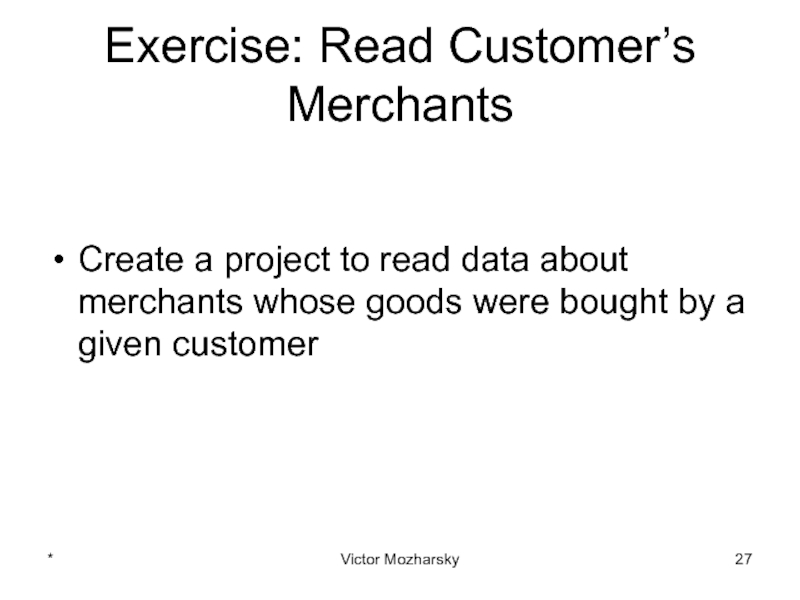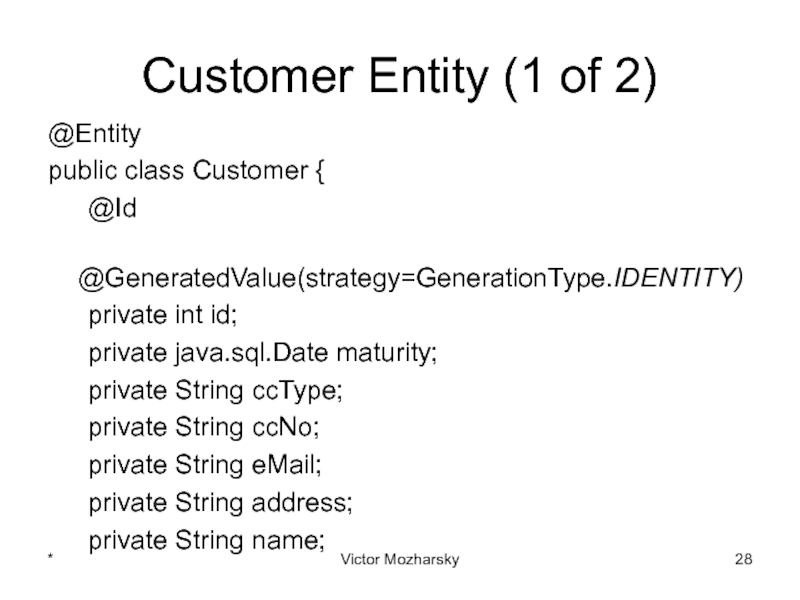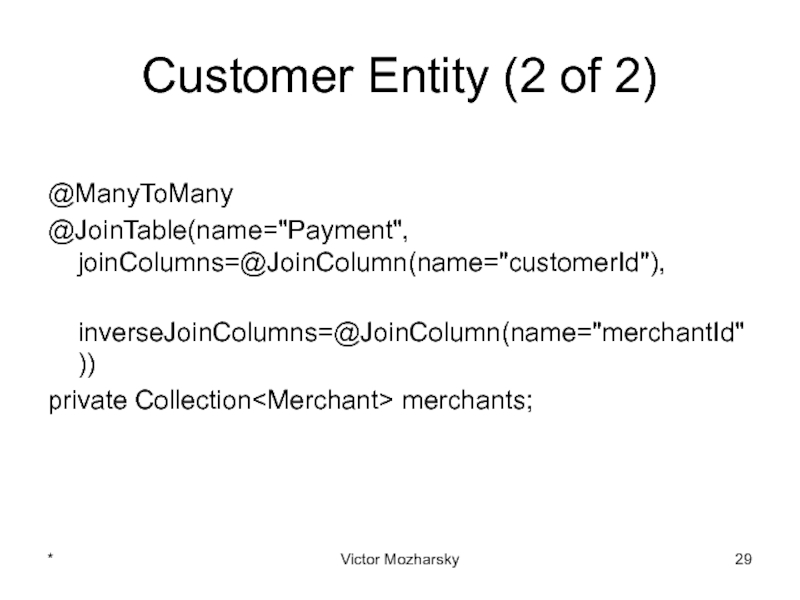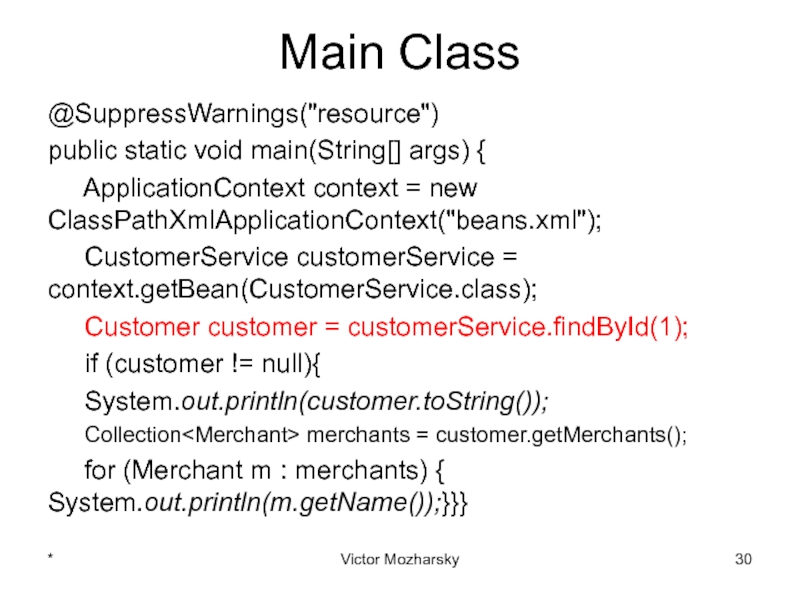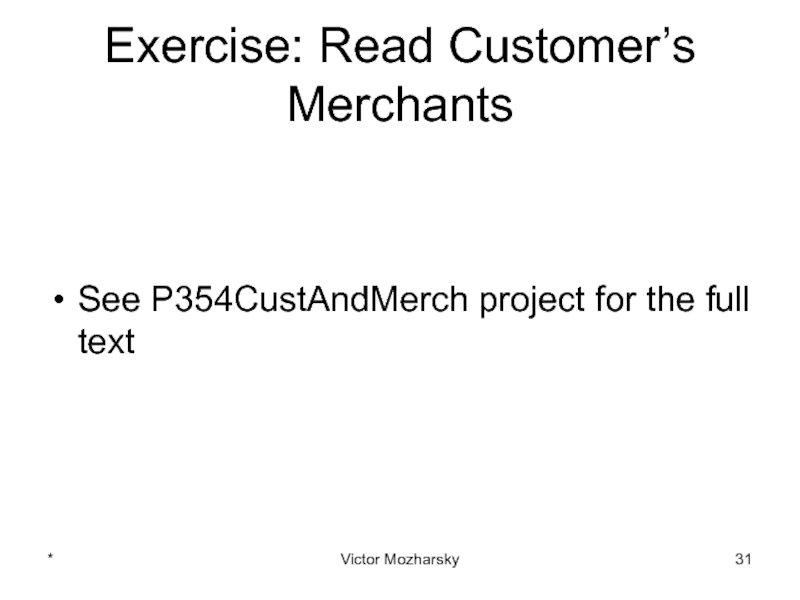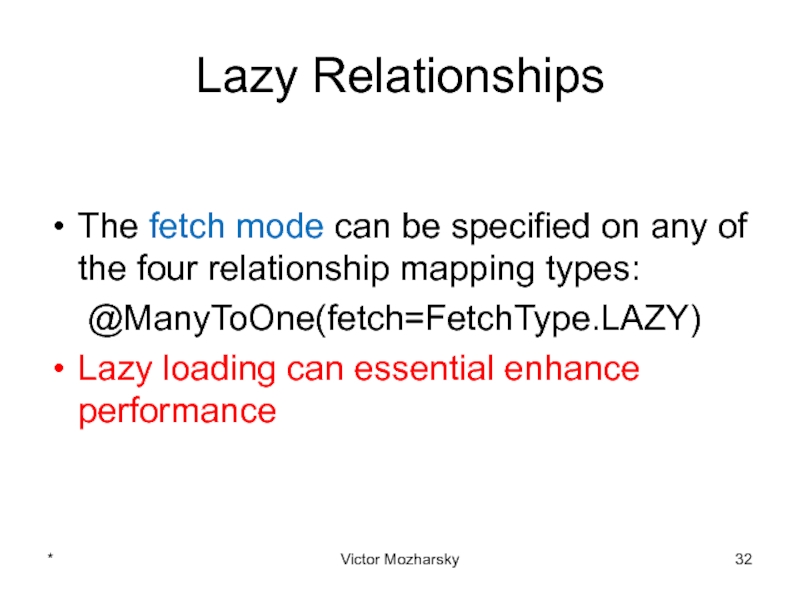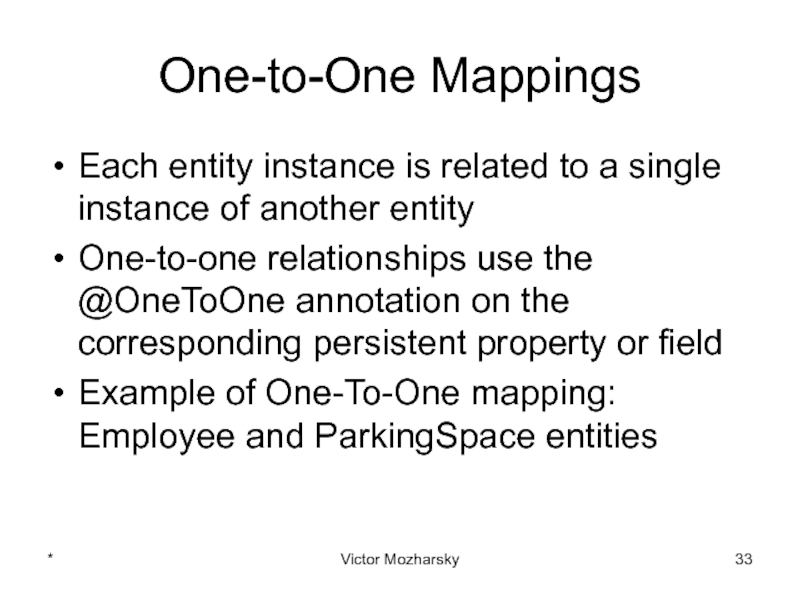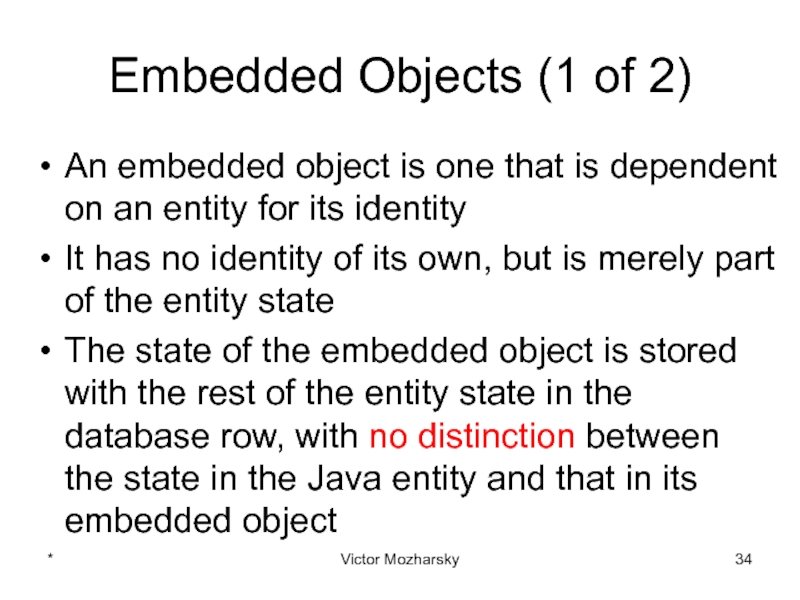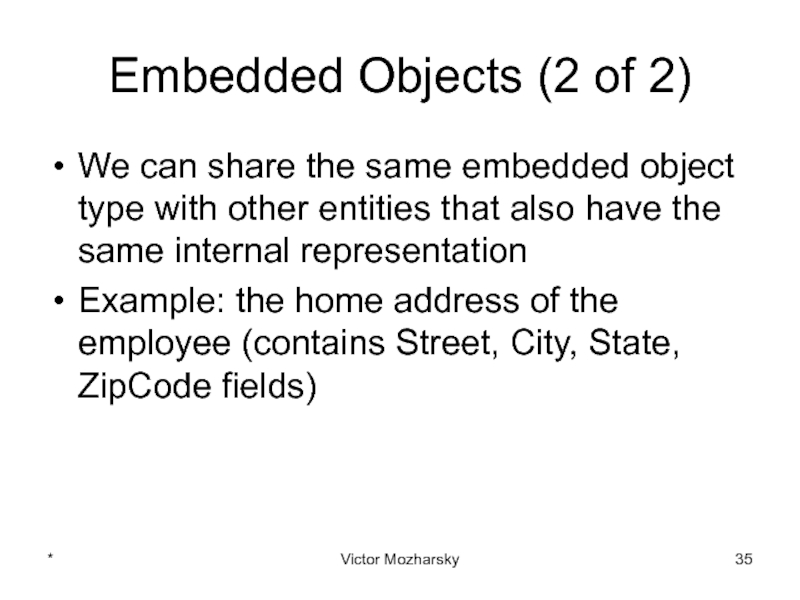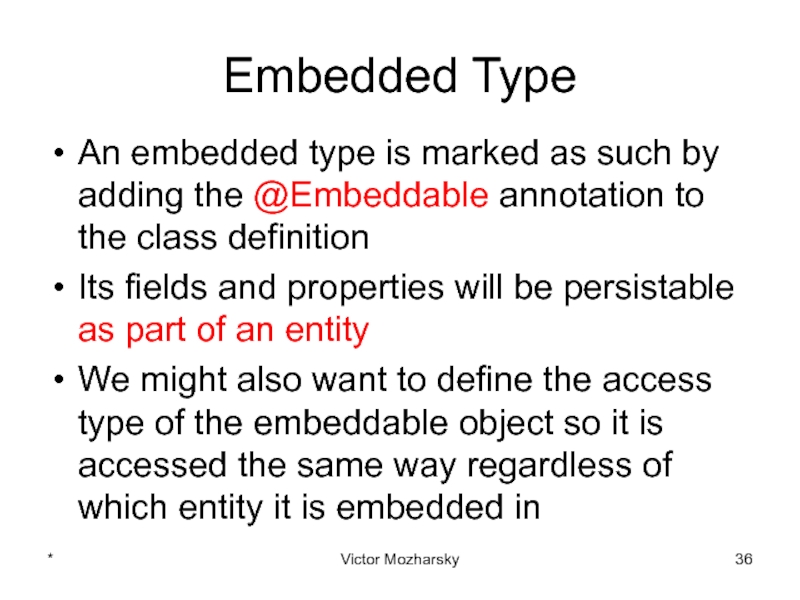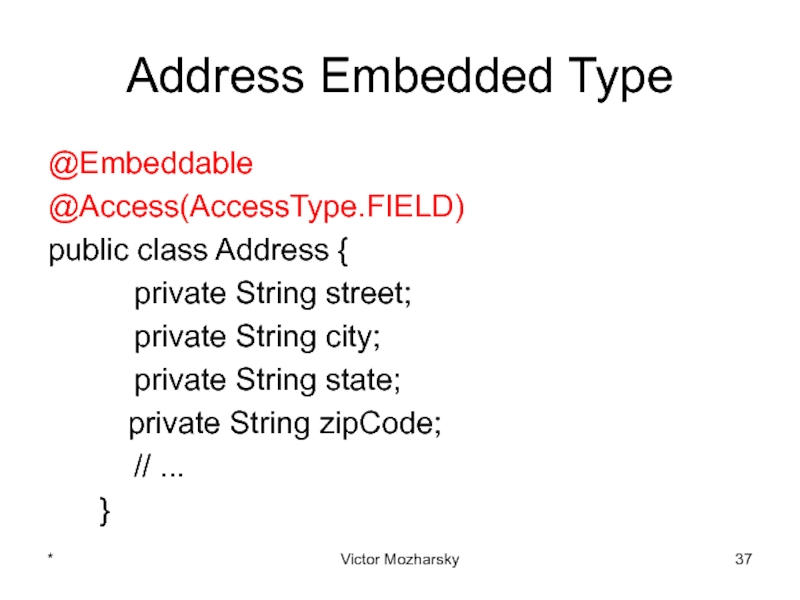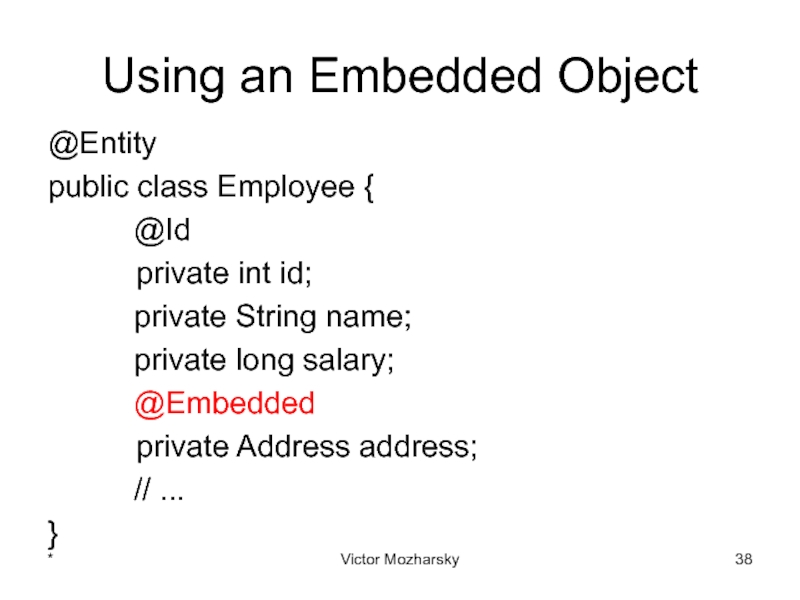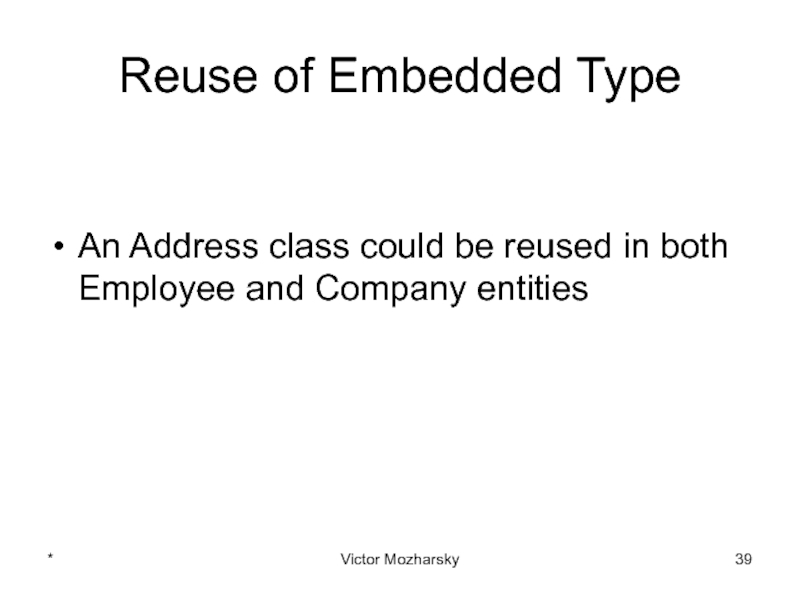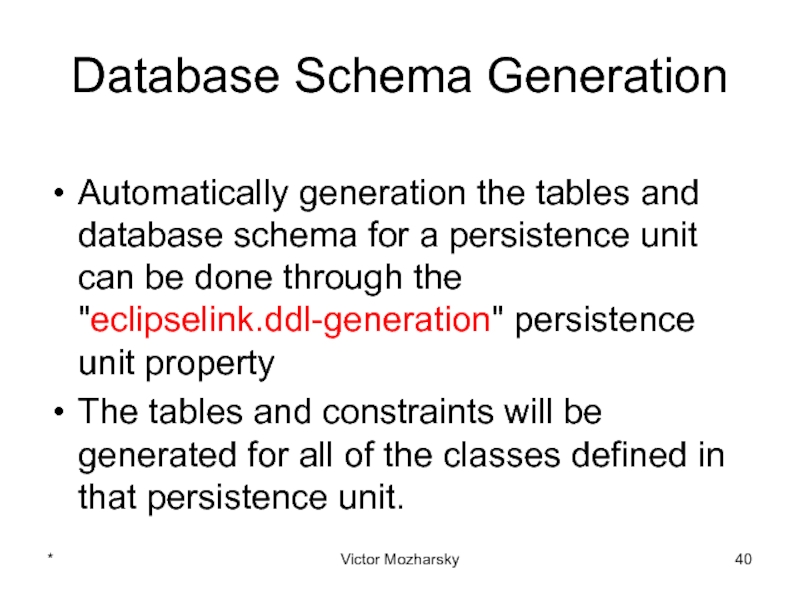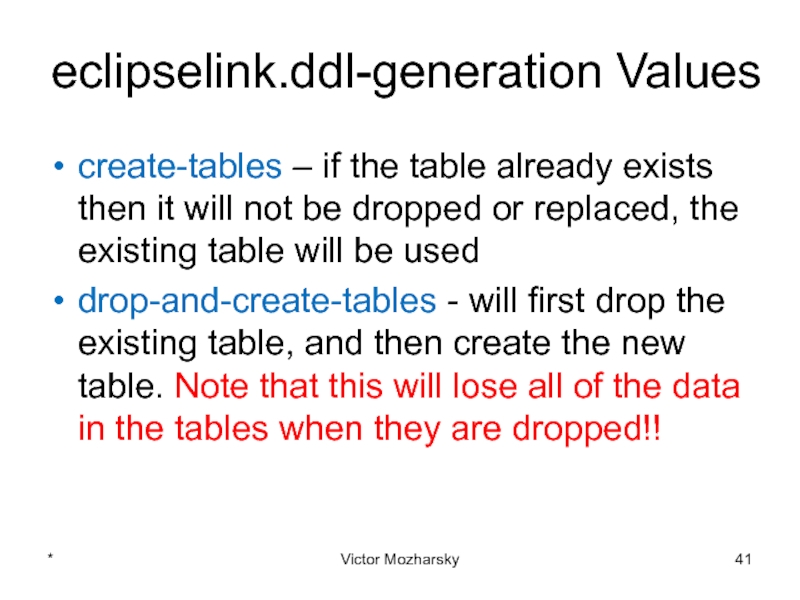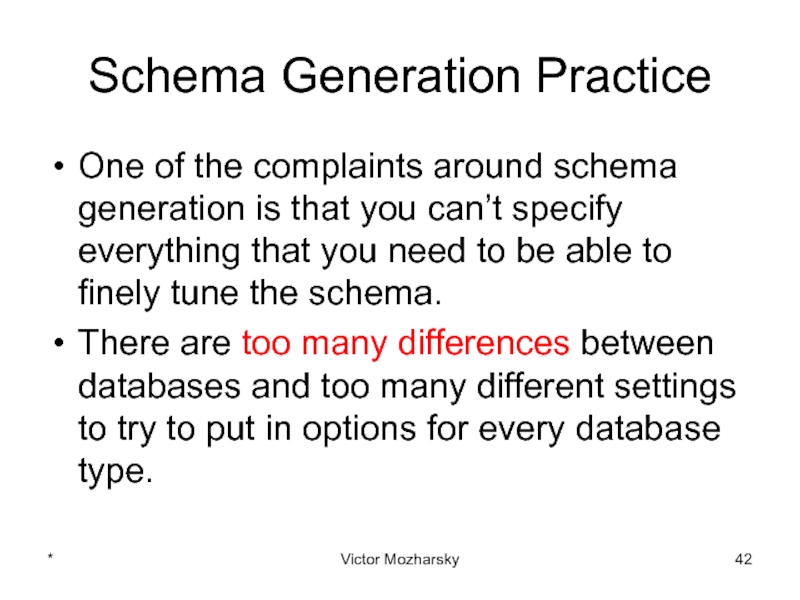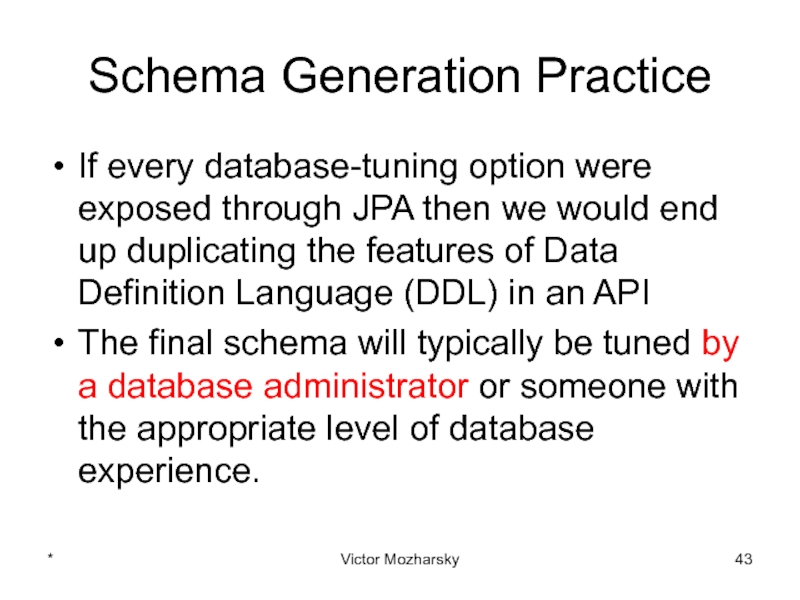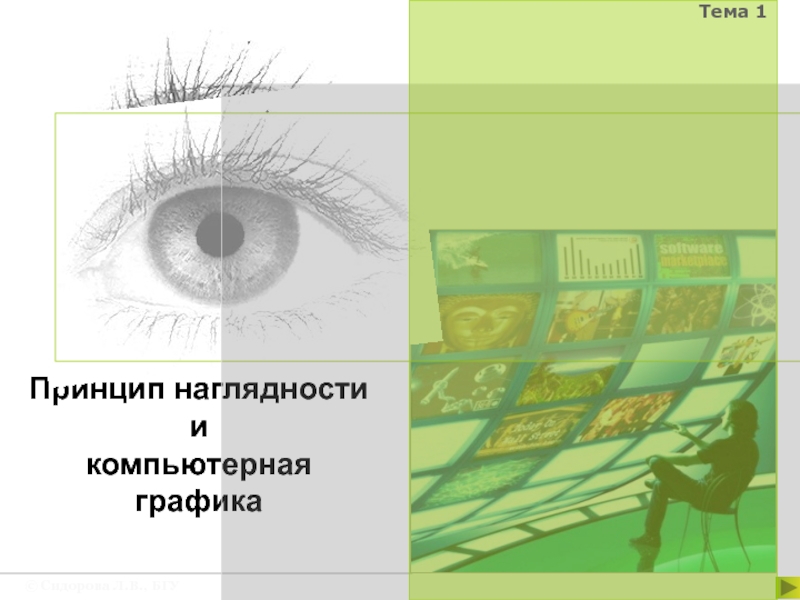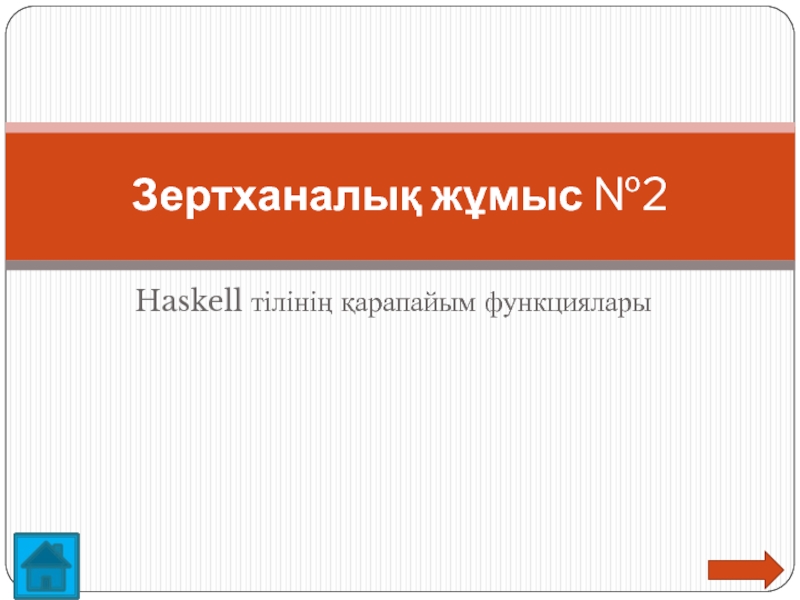- Главная
- Разное
- Дизайн
- Бизнес и предпринимательство
- Аналитика
- Образование
- Развлечения
- Красота и здоровье
- Финансы
- Государство
- Путешествия
- Спорт
- Недвижимость
- Армия
- Графика
- Культурология
- Еда и кулинария
- Лингвистика
- Английский язык
- Астрономия
- Алгебра
- Биология
- География
- Детские презентации
- Информатика
- История
- Литература
- Маркетинг
- Математика
- Медицина
- Менеджмент
- Музыка
- МХК
- Немецкий язык
- ОБЖ
- Обществознание
- Окружающий мир
- Педагогика
- Русский язык
- Технология
- Физика
- Философия
- Химия
- Шаблоны, картинки для презентаций
- Экология
- Экономика
- Юриспруденция
3. Java Persistence API. 4. Entity Relationships презентация
Содержание
- 1. 3. Java Persistence API. 4. Entity Relationships
- 2. Basics A foreign key can be one
- 3. Multiplicity in Entity Relationships Multiplicities are of
- 4. CM Database Schema * Victor Mozharsky
- 5. Many-to-One Mappings A many-to-one mapping is defined
- 6. Exercise: Read a Payment Create a project
- 7. CM Database Schema * Victor Mozharsky
- 8. Payment Entity (1 of 2) @Entity public
- 9. Payment Entity (2 of 2) public Merchant
- 10. DAO & Service Interfaces public interface PaymentDao
- 11. PaymentDaoImpl Class public Payment findById(int id){ return em.find(Payment.class, id); } * Victor Mozharsky
- 12. Main Class @SuppressWarnings("resource") public static void main(String[]
- 13. Exercise: Read a Payment See P351ReadPayment project for the full text * Victor Mozharsky
- 14. Exercise: Group Payments Modify P237Grouping project using entities from the previous project * Victor Mozharsky
- 15. PaymentDaoImp Class public List getTotalReport(){
- 16. Main Class @SuppressWarnings("resource") public static void main(String[]
- 17. Exercise: Group Payments See P352GroupPayment project for the full text * Victor Mozharsky
- 18. One-to-Many Mappings An entity instance can be
- 19. Exercise: Read a Merchant’s Payments Create a
- 20. CM Database Schema * Victor Mozharsky
- 21. Merchant Entity @Entity public class Merchant {
- 22. Main Class (1 of 2) @SuppressWarnings("resource") public
- 23. Main Class (2 of 2) System.out.println(" ");
- 24. Exercise: Read a Merchant’s Payments See P353MerchantPayments
- 25. Many-to-Many Mappings The entity instances can be
- 26. @JoinTable Annotation @JoinTable(name=“table name”, joinColumns=@JoinColumn(name=“c1Id”), inverseJoinColumns= @JoinColumn(name=“c2Id”)) * Victor Mozharsky
- 27. Exercise: Read Customer’s Merchants Create a project
- 28. Customer Entity (1 of 2) @Entity public
- 29. Customer Entity (2 of 2) @ManyToMany @JoinTable(name="Payment",
- 30. Main Class @SuppressWarnings("resource") public static void main(String[]
- 31. Exercise: Read Customer’s Merchants See P354CustAndMerch project for the full text * Victor Mozharsky
- 32. Lazy Relationships The fetch mode can be
- 33. One-to-One Mappings Each entity instance is related
- 34. Embedded Objects (1 of 2) An embedded
- 35. Embedded Objects (2 of 2) We can
- 36. Embedded Type An embedded type is marked
- 37. Address Embedded Type @Embeddable @Access(AccessType.FIELD)
- 38. Using an Embedded Object @Entity public
- 39. Reuse of Embedded Type An Address class
- 40. Database Schema Generation Automatically generation the tables
- 41. eclipselink.ddl-generation Values create-tables – if the table
- 42. Schema Generation Practice One of the complaints
- 43. Schema Generation Practice If every database-tuning option
Слайд 2Basics
A foreign key can be one or more columns that reference
A foreign key and the primary parent key it references must have the same number and type of fields
Foreign keys represents relationships from a column or columns in one table to a column or columns in another table
*
Victor Mozharsky
Слайд 3Multiplicity in Entity Relationships
Multiplicities are of the following types:
Many-to-one: Multiple instances
One-to-one: Each entity instance is related to a single instance of another entity
One-to-many: An entity instance can be related to multiple instances of the other entities
Many-to-many: The entity instances can be related to multiple instances of each other.
*
Victor Mozharsky
Слайд 5Many-to-One Mappings
A many-to-one mapping is defined by annotating the attribute in
A @JoinColumn(name=Fkname) annotation discribes a foreing key of a relationship
*
Victor Mozharsky
Слайд 6Exercise: Read a Payment
Create a project for read payment data by
*
Victor Mozharsky
Слайд 8Payment Entity (1 of 2)
@Entity
public class Payment {
@Id
@GeneratedValue(strategy=GenerationType.IDENTITY)
private int id;
private
private double total;
private String goods;
private java.sql.Date dt;
@ManyToOne
@JoinColumn(name="merchantId")
private Merchant merchant;
*
Victor Mozharsky
Слайд 9Payment Entity (2 of 2)
public Merchant getMerchant(){ return merchant; }
public void
merchant = value;
}
. . . . . . . . . . . . . . . .
public String getStringForPrint() {
String txt = "id = " + id + "; date = ";
SimpleDateFormat dtFrm = new SimpleDateFormat("dd.MM.yyyy");
txt += dtFrm.format(dt) + "; merchant = " + merchant.getName();
txt += "; total = " + total + "; charge = " + charge;
return txt;
}
*
Victor Mozharsky
Слайд 10DAO & Service Interfaces
public interface PaymentDao {
public List findByMerchantId(int id);
public double
public Payment findById(int id);
}
public interface PaymentService {
public List
public double getPaymentSum();
public Payment findById(int id);
}
*
Victor Mozharsky
Слайд 11PaymentDaoImpl Class
public Payment findById(int id){
return em.find(Payment.class, id);
}
*
Victor Mozharsky
Слайд 12Main Class
@SuppressWarnings("resource")
public static void main(String[] args) {
ApplicationContext context
PaymentService paymentService = context.getBean(PaymentService.class);
Payment p = paymentService.findById(2);
System.out.println(p.toString());
}
*
Victor Mozharsky
Слайд 14Exercise: Group Payments
Modify P237Grouping project using entities from the previous project
*
Victor
Слайд 15PaymentDaoImp Class
public List getTotalReport(){
String txt = "SELECT new com.bionic.edu.Result
(p.merchant.name, count(p), SUM(p.chargePayed))";
txt += "FROM Payment p GROUP BY p.merchant.name";
TypedQuery
return query.getResultList();
}
*
Victor Mozharsky
Слайд 16Main Class
@SuppressWarnings("resource")
public static void main(String[] args) {
ApplicationContext context
PaymentService paymentService = context.getBean(PaymentService.class);
List
for(Result r: list)
System.out.format("%1$25s %2$3d %3$8.2f \n", r.getName(), r.getCount(), r.getSum());
}
*
Victor Mozharsky
Слайд 18One-to-Many Mappings
An entity instance can be related to multiple instances of
One-to-many relationships use the @OneToMany annotation on the corresponding persistent property or field
The mappedBy element is needed to refer to the attribute annotated by ManyToOne in the corresponding entity:
@OneToMany(mappedBy=“attribute”)
A one-to-many association needs to map the collection of entities
*
Victor Mozharsky
Слайд 19Exercise: Read a Merchant’s Payments
Create a project for read payment data
*
Victor Mozharsky
Слайд 21Merchant Entity
@Entity
public class Merchant {
@Id
@GeneratedValue(strategy=GenerationType.IDENTITY)
private int id;
private String name;
private double
private int period;
private double total;
@OneToMany(mappedBy="merchant")
private Collection
*
Victor Mozharsky
Слайд 22Main Class (1 of 2)
@SuppressWarnings("resource")
public static void main(String[] args) {
MerchantService merchantService = context.getBean(MerchantService.class);
List
for(Merchant m: list){
System.out.println("=======================");
System.out.println(m.getName());
*
Victor Mozharsky
Слайд 23Main Class (2 of 2)
System.out.println(" ");
Collection payments = m.getPayments();
for (Payment p
System.out.println(p.toString());
}
}
}
*
Victor Mozharsky
Слайд 24Exercise: Read a Merchant’s Payments
See P353MerchantPayments project for the full text
*
Victor
Слайд 25Many-to-Many Mappings
The entity instances can be related to multiple instances of
Many-to-many relationships use the @ManyToMany annotation on the corresponding persistent property or field
We must use a third table to associate the two entity types (join table)
*
Victor Mozharsky
Слайд 26@JoinTable Annotation
@JoinTable(name=“table name”,
joinColumns=@JoinColumn(name=“c1Id”),
inverseJoinColumns=
@JoinColumn(name=“c2Id”))
*
Victor Mozharsky
Слайд 27Exercise: Read Customer’s Merchants
Create a project to read data about merchants
*
Victor Mozharsky
Слайд 28Customer Entity (1 of 2)
@Entity
public class Customer {
@Id
@GeneratedValue(strategy=GenerationType.IDENTITY)
private int id;
private
private String ccType;
private String ccNo;
private String eMail;
private String address;
private String name;
*
Victor Mozharsky
Слайд 29Customer Entity (2 of 2)
@ManyToMany
@JoinTable(name="Payment", joinColumns=@JoinColumn(name="customerId"),
inverseJoinColumns=@JoinColumn(name="merchantId"))
private Collection merchants;
*
Victor Mozharsky
Слайд 30Main Class
@SuppressWarnings("resource")
public static void main(String[] args) {
ApplicationContext context
CustomerService customerService = context.getBean(CustomerService.class);
Customer customer = customerService.findById(1);
if (customer != null){
System.out.println(customer.toString());
Collection
for (Merchant m : merchants) { System.out.println(m.getName());}}}
*
Victor Mozharsky
Слайд 31Exercise: Read Customer’s Merchants
See P354CustAndMerch project for the full text
*
Victor Mozharsky
Слайд 32Lazy Relationships
The fetch mode can be specified on any of the
@ManyToOne(fetch=FetchType.LAZY)
Lazy loading can essential enhance performance
*
Victor Mozharsky
Слайд 33One-to-One Mappings
Each entity instance is related to a single instance of
One-to-one relationships use the @OneToOne annotation on the corresponding persistent property or field
Example of One-To-One mapping: Employee and ParkingSpace entities
*
Victor Mozharsky
Слайд 34Embedded Objects (1 of 2)
An embedded object is one that is
It has no identity of its own, but is merely part of the entity state
The state of the embedded object is stored with the rest of the entity state in the database row, with no distinction between the state in the Java entity and that in its embedded object
*
Victor Mozharsky
Слайд 35Embedded Objects (2 of 2)
We can share the same embedded object
Example: the home address of the employee (contains Street, City, State, ZipCode fields)
*
Victor Mozharsky
Слайд 36Embedded Type
An embedded type is marked as such by adding the
Its fields and properties will be persistable as part of an entity
We might also want to define the access type of the embeddable object so it is accessed the same way regardless of which entity it is embedded in
*
Victor Mozharsky
Слайд 37Address Embedded Type
@Embeddable
@Access(AccessType.FIELD)
public class Address {
private String city;
private String state;
private String zipCode;
// ...
}
*
Victor Mozharsky
Слайд 38Using an Embedded Object
@Entity
public class Employee {
private int id;
private String name;
private long salary;
@Embedded
private Address address;
// ...
}
*
Victor Mozharsky
Слайд 39Reuse of Embedded Type
An Address class could be reused in both
*
Victor Mozharsky
Слайд 40Database Schema Generation
Automatically generation the tables and database schema for a
The tables and constraints will be generated for all of the classes defined in that persistence unit.
*
Victor Mozharsky
Слайд 41eclipselink.ddl-generation Values
create-tables – if the table already exists then it will
drop-and-create-tables - will first drop the existing table, and then create the new table. Note that this will lose all of the data in the tables when they are dropped!!
*
Victor Mozharsky
Слайд 42Schema Generation Practice
One of the complaints around schema generation is that
There are too many differences between databases and too many different settings to try to put in options for every database type.
*
Victor Mozharsky
Слайд 43Schema Generation Practice
If every database-tuning option were exposed through JPA then
The final schema will typically be tuned by a database administrator or someone with the appropriate level of database experience.
*
Victor Mozharsky
